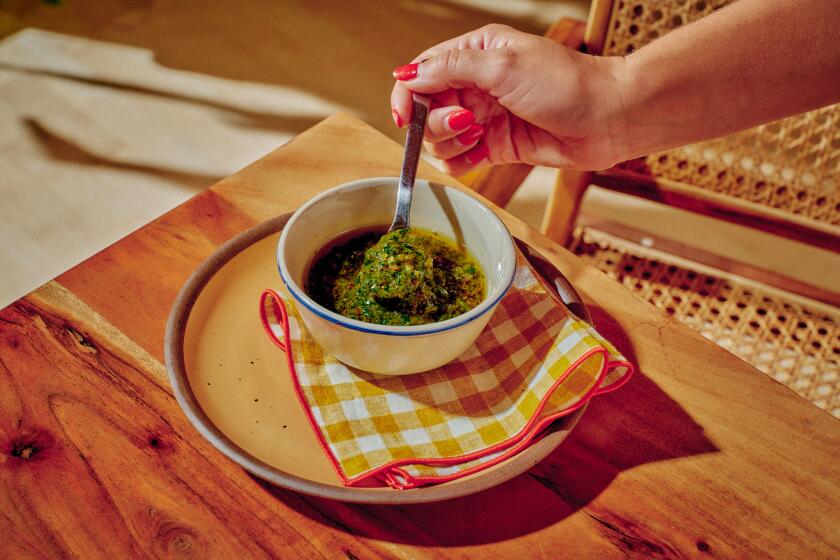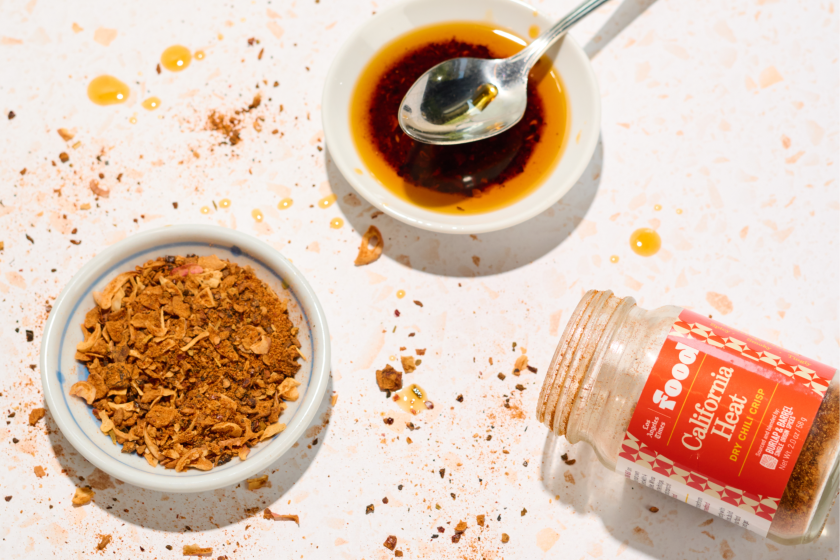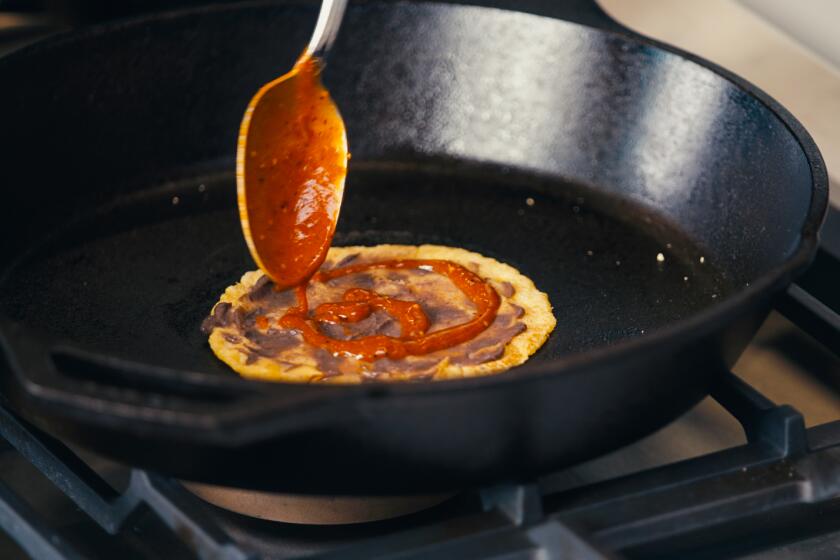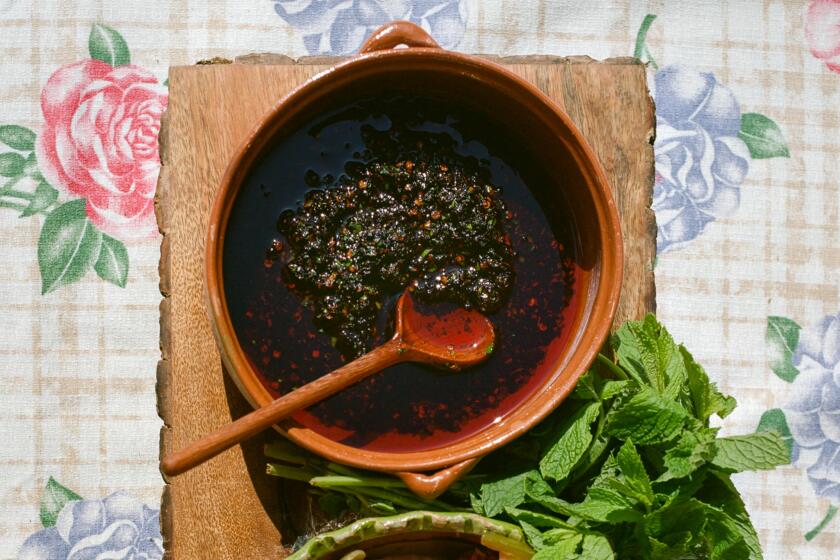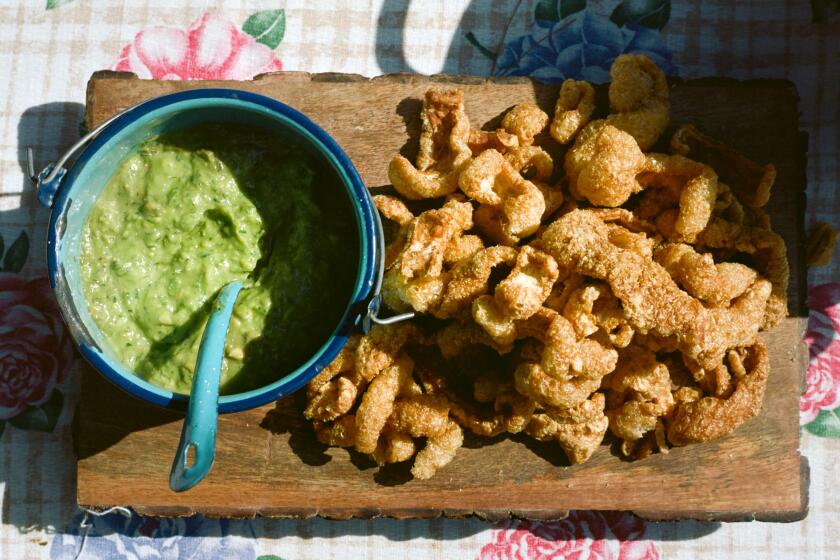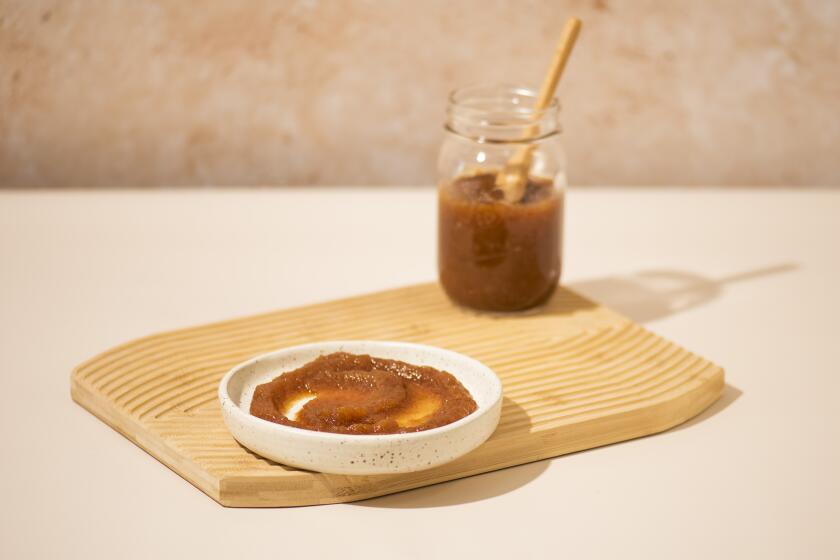Plum preserves
- Share via
Seems like we waited forever for great summer produce, and now it’s abundantly here -- too abundantly, if you’re a fruit-tree owner, overly enthusiastic vegetable gardener or incorrigible farmers market shopper. Got plums, ripening all at once? Neighbors with zucchini plants? A fatal attraction to heirloom tomatoes?
Just in time, there’s the new “Ball Complete Book of Home Preserving: 400 Delicious and Creative Recipes for Today” (Robert Rose Inc., $20), a 450-page compendium of recipes such as peach butter, prickly pear marmalade, orange rhubarb chutney or aubergine pickles. With sections on equipment, trouble-shooting guides and details on testing for jelling, etc., the book is a big sister to the magazine-size “Ball Blue Book” home canning guide that has been published in various forms since 1909.
Edited by two longtime Ball employees, test kitchen scientist Lauren Devine and consumer services manager Judi Kingry, “Home Preserving” is a must-have for home canning veterans for its many terrific new recipes pitched to contemporary tastes. If you’re comfortable with pickling techniques, you’ll find not only bread-and-butter slices, dilled green tomatoes, traditional corn relish and zucchini relish but also fennel relish and achar, a Southeast Asian relish combining onions, ginger, cucumbers, cauliflower, peanuts and sesame seeds.
But this cookbook is great for novices too because its breezy, fast-paced jump-in-and-do-it approach makes the techniques of home canning immediately accessible. And when you have a crop of peaches waiting to be processed, you don’t want to spend three days figuring out how to make jam.
Taking a cue from computer program tutorials, the authors dispense with the scary-sounding introductory material about bacteria and spoilage that everyone skips over anyway and instead propose that the newcomer learn by doing one of five basic recipes: strawberry jam, mint jelly, simple “house” salsa, traditional corn relish or pick-a-vegetable dill pickles. Each introductory recipe illustrates certain principles that are fully delineated in a back-of-the-book section on the science of preserving.
An elegant rendition
While other canning guides make you think the intended reader must be a modern-day homesteader or a survivalist, “Home Preserving” brings to mind the enthusiast who would like to enliven a dinner party with a house-made chutney (there are 18 possibilities in these pages), create his or her own mustards, or try a hand at delicacies such as preserved limes.
And the recipes work, though with caveats that should be remembered in all home canning projects. For example, it’s good to have on hand a bit more produce than is called for. Yields vary widely by varieties in some cases.
A peach butter recipe made with less sugar than is traditional and the addition of amaretto or sweet wine is quick and easy as canning recipes go, updated by deleting a poaching step that many peach butter recipes call for. But in two different tests, the called-for amount of peaches yielded different amounts of peach puree (which is specified at midpoint, so you can adjust).
The basic plum preserves recipe from the “Blue Book” still makes great, rich preserves with the deep caramelized flavor gained from long cooking, but in one of the new book’s few misguided updates, the recipe now calls for halved plums. Try halving a plum; it has to be exactly the correct ripeness to achieve this miracle without ripping or liquefying and there’s no need for pristine halves when making preserves.
But aside from safety techniques (don’t vary from instructions calling for use of a pressure-cooker, for example), home preserving recipes are forgiving and flexible and the authors take advantage of this principle, as in a hot pickle mix recipe that allows you to calibrate the heat by using three to nine jalapenos. And the recipe for achar is an example of the recipes that beckon because they allow you to create something better than what’s commercially available. It’s an attractive and flavorful relish to have on hand and serve with grilled foods and rice dishes.
Late summer and fall are the traditional canning seasons, though Californians find themselves preserving citrus in January and February. We may just be, as usual, ahead of the curve, with a trend toward year-round home preserving. “Home Preserving” has recipes that will inspire you to try your hand at curry raisin jelly, cranberry chutney, maple-walnut syrup or Vietnamese carrot and daikon pickle long after summer produce has been put by.
Prepare the canner, jars and lids by washing and rinsing the jars and lids, placing a rack in the bottom of a boiling-water canner and placing the jars in the rack, adding water to fill and cover the jars. Cover the canner and bring the water to a simmer (boiling the jars or pre-sterilization is unnecessary); keep the jars hot until ready to use.
While the water in the canner is heating, pit and halve or roughly chop the plums, adding them to a large, deep stainless steel pot as you go. Add the sugar and 1 cup water. Cover and bring to a boil over medium heat, about 15 minutes, stirring occasionally to dissolve the sugar. Place a few small saucers in the freezer to chill.
Increase the heat to high and boil hard, stirring frequently, until the mixture thickens, about 45 to 50 minutes. Remove from the heat and test the gel by placing a teaspoonful of the preserves on the saucer and chilling in the freezer for 1 minute. Remove the saucer from the freezer and push the edge of the preserves with your finger. A mixture that has reached the gel stage will be set and the surface will wrinkle when the edge is pushed. If the mixture has not reached the gel stage, return it to the heat and continue to cook, testing every few minutes until the gel stage is reached. Skim off the foam.
Ladle hot preserves into hot jars, leaving one-fourth-inch headspace. Remove air bubbles and adjust the headspace if necessary by adding hot preserves. Wipe the rim. Center the lid on the jar. Screw the band down until resistance is met, then increase to fingertip-tight.
Place the filled jars in the canner, ensuring they are completely covered with water. Cover and bring to a boil, then process for 15 minutes. Remove from the heat. Remove the canner lid. Wait 5 minutes, then remove the jars. Cool and store.
Get our Cooking newsletter.
Your roundup of inspiring recipes and kitchen tricks.
You may occasionally receive promotional content from the Los Angeles Times.










